

Table of contents
- The general structure
- Load capacity
- thermal insulation
- seal
- Advantages and disadvantages
- Tilt
- Classic building materials
- Structure
- insulation
- seal
- topping
- construction principles
- 1. on-roof insulation
- 1b. Special case inverted roof
- 2. in-roof insulation
- 3. under-roof insulation
- The edge of the roof
- With roof overhang
- At Attica
Previously reserved primarily for inexpensive functional buildings, the flat roof has enjoyed great popularity in residential and representative buildings since the classic modern era from the 1020s. Its structure is just as varied as its use. Here we explain the most common flat roof constructions and explain their advantages and disadvantages.
The general structure
Like all other types of roof, the flat roof generally has to meet three basic requirements. These can be provided by one and the same component of the structural design, but can also clearly "stand in each other's way".
Load capacity
Every flat roof structure must be stable enough to absorb the following loads and transfer them safely to the supporting components, i.e. walls or columns:
- construction – i.e. the weight of the roof itself
- precipitation – the weight of rainwater and especially snow
- traffic loads - Depending on the type of roof use, either craftsmen for revision, or - when used as a roof terrace - people, furniture, plants, etc.
thermal insulation
For heated buildings, the Energy Saving Ordinance ENEV requires a minimum standard for thermal insulation of the flat roof in order to limit the amount of energy escaping through the roof surfaces. Although this is not necessary for unheated buildings, a minimum insulation to prevent condensation according to DIN4108 may still be necessary, depending on the use.
seal
Finally, the flat roof should of course protect against the adversities of the weather, i.e. wind and precipitation. For this purpose, the structural design must provide for a dense level. As a rule, this should be designed in such a way that problems that occur, such as a clogged drain or a defective rain gutter, do not immediately lead to water damage in the construction.
Advantages and disadvantages
Finally, the main advantages and disadvantages of the flat roof should be summarized clearly at this point:
Advantages
- Low installation height
- Well usable on the top (e.g. B. roof terrace)
- Restrained to invisible appearance
- Production by horizontal installation of insulation and sealing can be implemented quite easily
- No lost attic space underneath, since the room is horizontally closed at the top
Disadvantages
- Slow water drainage through no or low inclination
- In the event of leaks, water can quickly enter the construction
- Internal drainage is complex and prone to failure
- No snow slipping due to the lack of a slope
- No self-cleaning effect due to the low rinsing effect of the slowly draining rainwater
Tilt
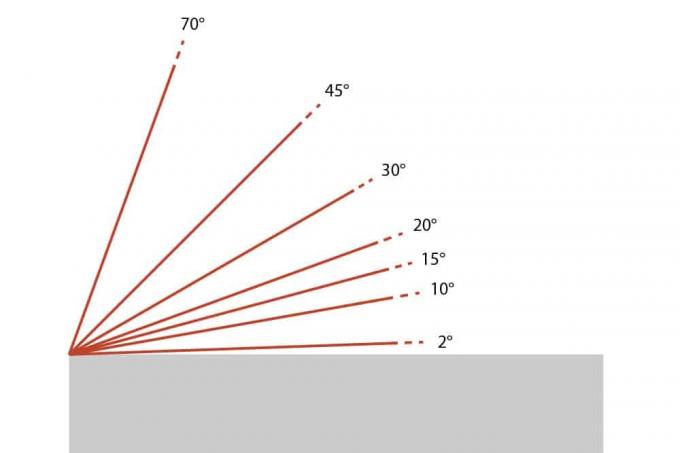
Even if the flat roof is flat, this does not automatically mean that it must not have any slope at all. Even on the contrary. If you follow the specifications of the flat roof guideline when constructing the flat roof, the roof must have a Inclination of at least two percent in the direction of the drainage points - roof drains or rain gutters - exhibit. Either the entire roof can be inclined, or only the sealing level is, for example, above a tapered slope insulation on a completely horizontal construction plane with the slope Mistake. This inclination means that rainwater is directed to the draining components. At the same time, the degree of inclination, which appears to be quite high, takes into account that deviations can always occur in the execution. If the slope is too low, water pockets would form even with small differences in level, in which rainwater would stand permanently and put a strain on the construction. At the top, the demarcation of the flat roof is compared to steeper ones roof shapes not clearly defined. Usually one speaks from approx. three to five degrees no longer from a real flat roof, but from a gently sloping roof.
INFO:
The specified minimum inclination does not necessarily have to be observed. Again and again real flat roofs with a zero degree inclination are realized. However, the inclination value reflects the experience of the flat roof builder and should help to avoid moisture damage as far as possible
Classic building materials
Contrary to various other roof shapes, the flat roof is quite limited in terms of the building materials used to create it. This is primarily due to the constructive challenges of the minimal inclination and a possible use of the roof area. Supporting structure, insulation and sealing have to adapt to this and react to the challenges of these peculiarities.
Structure
The following support structures have been established:
- Homogeneous reinforced concrete slab
- Steel or concrete beams with suspended concrete elements
- Wooden beam with wooden covering as a load-bearing level
- Steel girders with wood or metal covering (then usually trapezoidal sheet metal)
insulation
Proven insulation variants are:
- Foamed plastics as classic insulating materials for laying on flat levels, e.g. B. Reinforced concrete slab or wooden covering
- Foam glass as a flat covering, see above
- Mineral wool, cellulose insulation and other soft insulation materials for installation in cavities between load-bearing elements
SPECIAL CASE: sandwich panels
Here, foamed plastics are used directly with a trapezoidal sheet as a combination of insulation level and flat supporting structure.
seal
When it comes to sealing, there are ultimately only two common variants for the flat roof:
- foil – Plastic film for bonding to flat surfaces, e.g. B. a pressure-resistant insulation
- bitumen – Bitumen-containing sealing membranes that are not glued but welded on by smoldering and liquefying the bitumen
topping
Usually not necessary for the pure function of the flat roof as part of the building shell, different coverings on the roof can bring various advantages:
- Greening: Delay in the discharge of rainwater, ecological added value, visual enhancement
- Gravel: Mechanical protection of the seal, ballast to protect against wind suction, UV protection of plastic and bitumen seals
- Floor coverings: To use the roof surface as a terrace, as a slab covering or wooden grating, it can be produced on level ground in the same way as terraces
construction principles
If you now know the essential requirements for a flat roof, as well as the catalog of common components, it is now necessary to combine both to form a functioning overall construction. Despite the number of possible combinations that initially appears very high, there are actually only a few general systems according to which a functioning flat roof is usually created:
1. on-roof insulation
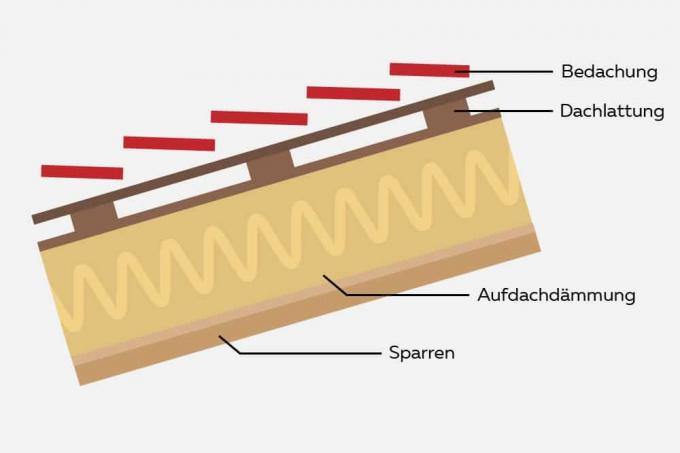
With this classic and simple form of flat roof, the components are simply stacked on top of each other. At the bottom is the supporting structure, i.e. the concrete slab, or the wooden covering on a support level. This is followed by the insulation layer. This must be so pressure-resistant that it can absorb the following components and a possible snow load and, if necessary, withstand the use of the roof. The seal is now applied to the insulating layer as a flat substructure. It protects the entire construction, and of course also the building covered with the flat roof. An individual covering can now be applied to the seal, or the seal can remain as the highest functional conclusion of the construction.
1b. Special case inverted roof
A special form of the flat roof structure just described is the so-called inverted roof. In this case, the insulation is not installed under the protective seal, but placed on top of the seal. The seal is therefore located directly on the load-bearing level. For this type of roof structure, the insulating layer must be laid without joints or gaps in order to prevent the penetration of heat-conducting rainwater as far as possible. In addition, the insulation itself must be able to withstand constant moisture. This construction is usually completed by a protective membrane and a layer of gravel to secure the insulation in place.
A NOTICE:
Frequently used in the 1980s and 1990s, this construction can still be found in existing buildings. On the other hand, it is only rarely rebuilt due to the technical insulation difficulties.
2. in-roof insulation

If the flat roof is created from a carrier layer with panel materials on top, this is an option the possibility of not laying the insulation on top, but already putting it between the beams bring in The advantage is obvious with a significantly reduced construction height due to the missing dimensions of the insulation layer. On the other hand, the insulation must be secured downwards against falling out, so that a sub-ceiling with anti-trickle film and clamping battens cannot be avoided. In general, in-roof insulation is only suitable for wooden structures, since the wood itself has a certain insulating value. Steel or concrete girders, on the other hand, would cause blatant thermal bridges between the individual insulation packages with all the resulting problems.
3. under-roof insulation
For the sake of completeness, the sub-roof insulation should also be mentioned here. Here an existing roof is insulated from the underside. This can be done either by gluing and covering flat insulating materials, or by providing additional battens between which the insulation is installed. However, since the insulation can only be brought up to the walls supporting the supporting structure, it represents the most unfavorable variant imaginable and is usually only found in the renovation of old buildings. Because its advantage is clearly that it can be installed without having to open the existing roof or dismantle it completely.
The edge of the roof
In the case of flat roofs, particular attention is paid to the edge of the roof. Because the flat roof can either be provided with a roof overhang, or hide invisibly behind an attic, i.e. a surrounding wall. Depending on the desired solution, this places particular demands on the edge of the roof:
With roof overhang
- External drainage via rain gutter on one side or all around
- Roof pitch inclined outwards towards the gutter
- Guide the seal over the inlet plate in the channel
- When covering on waterproofing, water-permeable edge strips, e.g. B. Gravel strip, provide
A NOTICE:
Of course, a flat roof with a roof overhang can also be drained via internal drains. However, these are rarely used because they are more prone to failure than a gutter and also require numerous roof penetrations. The first choice is therefore usually the external gutter, through which the water simply runs out and drips off in the event of a clogged downpipe.
At Attica
- Guide the seal upwards around the parapet
- Sealing height according to DIN at least 15 cm above the top edge of the covering
- Pay attention to the bending radii of the sealing in the valley between the roof surface and the attic and provide an insulating wedge
- Upper sealing termination via clamping profile and overhang plate
- Internal drainage via roof drains, align slope to specific low point
- At least two drains required, alternatively emergency overflow as a second drain
- Protect the top of the attic against water, e.g. B. by sheeting
 Home editorial office
Home editorial office
Learn more about roof / attic
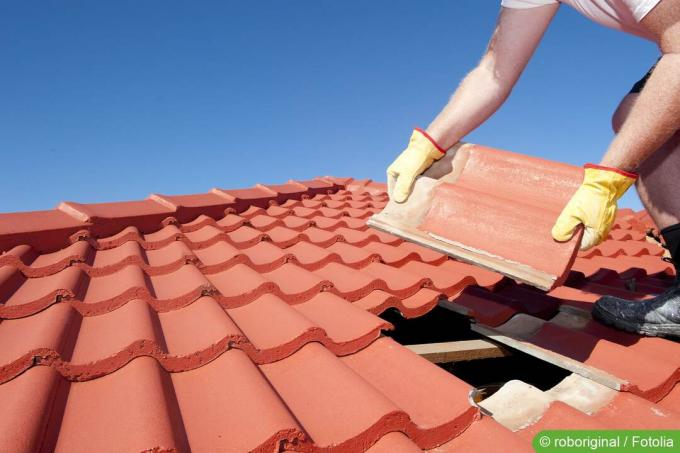
Snow blows under roof tiles: what to do?
Snow drifts often get under the roof tiles when blizzards or strong winds blow them underneath. The moisture often causes damage from meltwater. Air spaces between the roof tiles are to blame. Homeowners should now find out how to counteract this.
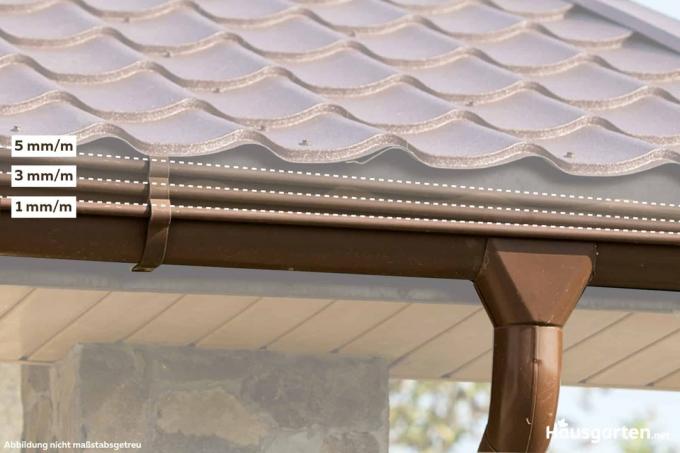
Gutter slope: the ideal gradient
For a gutter to function properly, a slope that has an ideal inclination is required. Various factors have to be taken into account. Before installation, you should find out how the gradient is to be calculated and implemented.
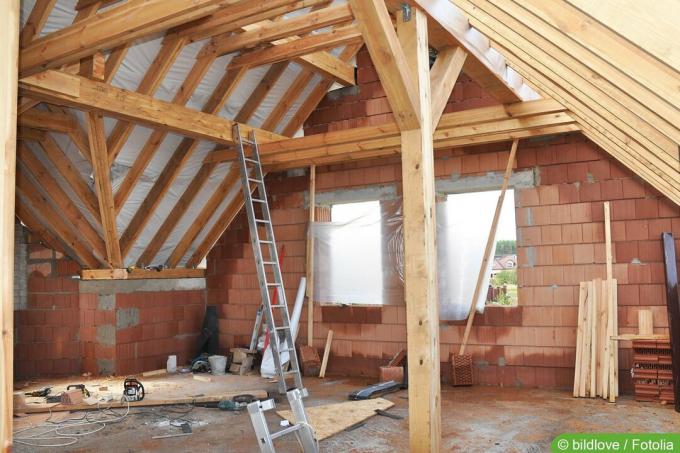
Which attic insulation can be walked on immediately?
Attic insulation effectively reduces heat loss from the building. If the attic is to continue to be used as storage space, the insulation should be accessible as soon as possible. A number of materials can be used for this. They each have advantages and disadvantages as well as different costs.
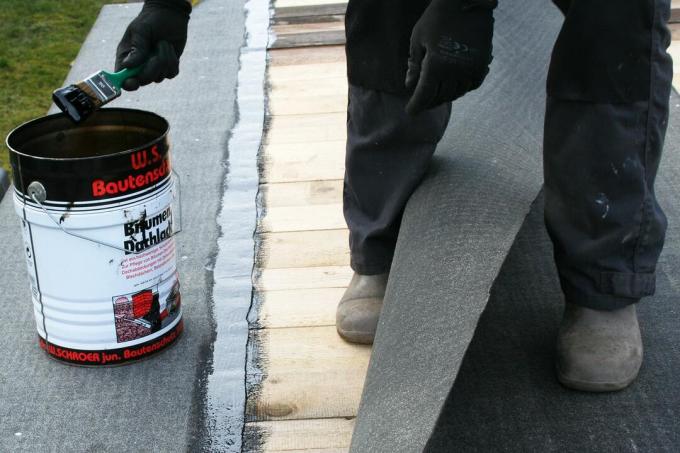
Bitumen stains: 6 removal tips
If you have to process bitumen, you should be careful. The black, viscous mass is sticky and adheres well to clothing, hands and all possible surfaces with which it comes into contact. With our tips you can successfully remove it.
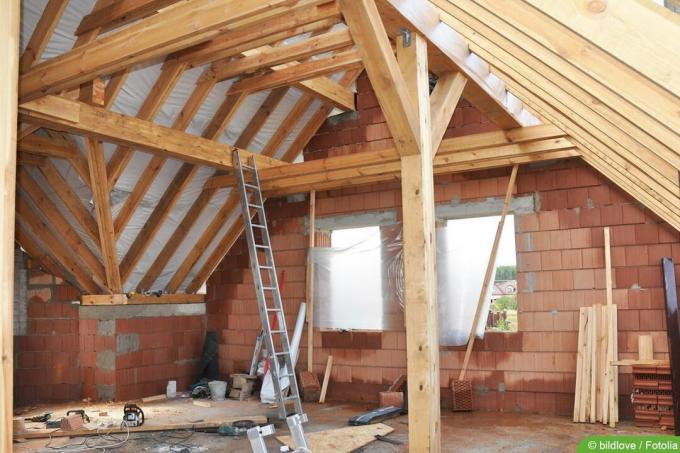
Attic: OSB or Rauspund as roof boarding?
Both OSB and Rauspund boards are suitable as roof boarding. But what are the differences and what is better suited for the attic? Our guide answers these and other questions about the two materials.

Laying a vapor barrier: how far does the vapor barrier have to go?
Laying a vapor barrier is essential in some cases. But how far does the vapor barrier have to be installed, what is it and what are the differences? These and more questions are answered in the following guide.


